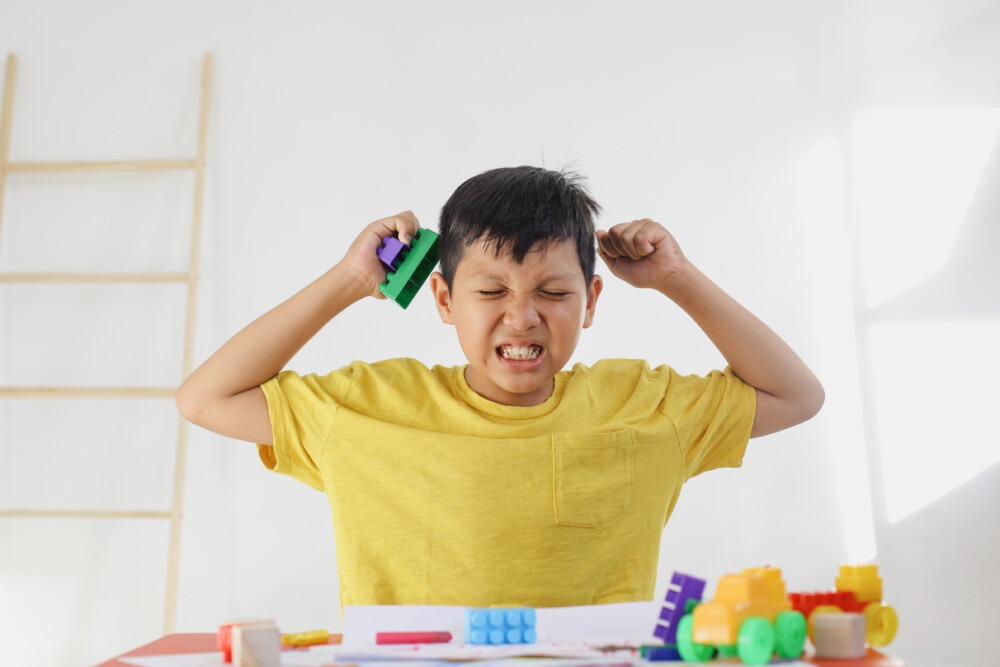Sensory Processing Disorder
What is Sensory Processing Disorder?
Sensory Processing Disorder (SPD) was formerly called Sensory Integration Disorder. It is a condition where sensory messages (taste, touch, visual, auditory) signal the brain incorrectly, causing children to have inappropriate motor and behavioral reactions to sensory stimuli. These children’s brains process sensory information differently from others.
SPD was initially pioneered by an occupational therapist and neuroscientist A. Jean Ayres, PhD as she compared SPD to a neurological “traffic jam” preventing certain parts of the brain from receiving the information needed to correctly interpret sensory information.
The accomplishment of everyday activities that we take for granted like eating, riding a bike, or wearing certain textured clothing relies on appropriate integration of sensory information and for those with sensory issues, watching a movie in a theater with loud noises and a variety of visual stimuli can be overwhelming.
One in 20 children is estimated to suffer from significant sensory processing issues like oversensitivity to lights, odors, noises, touch, balance, and taste. Some children have an overreactive response to sensory input while others have an underactive response to sensory stimulation including a lack of reaction to pain, heat, or cold.
SPD is more prevalent In children who are gifted and those with ADHD, Autism, and Fragile X syndrome than in the general population.
To find out more about SPD visit the Sensory Processing Disorder Foundation website.


CONVENTIONAL TREATMENT
Treatment for SPD is conventionally based on occupational therapy (OT). Play-based therapy sessions typically involve fun activities designed with sensory-stimulating environments. Occupational therapists often work with children in private clinics, hospital outpatient departments, and schools.
OT centers are often designed like a playground and OT sessions may involve physical activities such as swinging and spinning as well as tactile, visual, auditory, and taste experiences.
The goal of OT is to help children detect, regulate, interpret, and execute motor and behavioral responses appropriately in response to sensory stimuli so that they can function more comfortably in everyday life.
Training the family to be involved in the treatment is often critical to success.
You can read more about occupational therapy for sensory integration disorder here.
HOMEOPATHIC TREATMENT
Homeopathy can work well when combined with conventional occupational therapy (OT). Where OT helps children by desensitizing them to noxious sensory stimuli and by helping to modify the environment for the child from the outside in, Homeopathy works by stimulating a healing response in the body that helps restore balance to the sensory system from the inside out. Combining the two can offer the best of both worlds for a child suffering from SPDs.
The benefits to homeopathic treatment for children with SPDs are:
- Homeopathy can help sensory problems with sensitivities to light, noises, odors, textures, tastes, and touch.
- Because homeopathy is a holistic therapy, when we treat children with SPDs, we are also treating the whole body. If the child also suffers from other problems such as chronic recurrent ear infections, allergies, digestive problems, tantrums, violent behaviors, language delays, or other health concerns, these issues too may be helped by comprehensive homeopathic treatment.
RESEARCH STUDY:
Homeopathy Helped Sensory Processing Problems
A paper by Praful Bravalia out of India in 2011 shows a lot of promise for the ability of homeopathy to help children with sensory processing disorders. The outcomes-based study reported the results of treating 123 children with autism at the Spandan Holistic Multidisciplinary Institute from 1998 to 2009 and because there was a large subset of children in the study with sensory processing issues, the group was able to collect some valuable information on the effectiveness of homeopathy for children with SPDs.
Bravalia’s group measured treatment effectiveness with the ATEC (Autism Treatment Evaluation Check-list) scoring system developed by Dr. Bernard Rimland of the Autism Research Institute. It is an internationally recognized scoring system to measure changes in autistic symptoms after any treatment and has four subsets that also measure a range of symptom scores for the following categories: communication, sociability, sensory problems, and health and behavior.
Thirty-two of the children in the study were in a subgroup of data analyzed because they had pronounced sensory problems at the onset of the study. Their ATEC scores reduced from 73.68 at the time of starting homeopathic treatment to 55.74 after 12 months of treatment and continued to reduce further to 46.41 after 18 months—a 43% reduction in sensory symptoms in a year and a half of treatment!
This demonstrates the effectiveness of homeopathy for treating sensory processing problems. Since SPD’s are a long-standing chronic problem, this study was also valuable in showing the time frame in which to expect measurable improvements in symptoms.
The ATEC scores indicate that commitment to chronic, long-term treatment will yield far better results than expecting an immediate quick-fix.

Case Study: Sensory Processing Disorder
Alejandra was a feisty and intelligent 6-year-old female whose parents brought her for homeopathic treatment of violent temper tantrums and problems with loud noises, odors and lights. She was so sensitive to odors, she could detect a faint, disturbing smell from the other side of the house. Loud noises irritated her to the point she flew into a violent rage because they bothered her so much. She couldn’t tolerate bright lights and would always ask for the room to be dim and needed sunglasses to go outside.
Within a month of homeopathic treatment, Alejandra’s parents reported that she was like a new kid. She stopped throwing violent tantrums and was markedly less sensitive to noises, odors, and lights. Many children with sensory processing issues benefit from homeopathic treatment like Alejandra did.
References:
Bravalia, P. Autism Spectrum Disorder: Holistic Homeopathy. Homeopathic Links Spring 2011, Vol. 24: pp. 31-38.
Contact Us
Phone
480-716-7413
Join our Homeopathy for Autism group on Facebook
